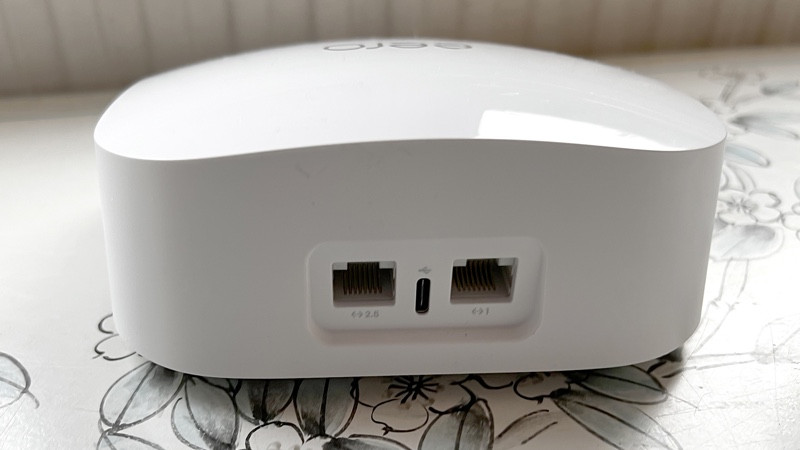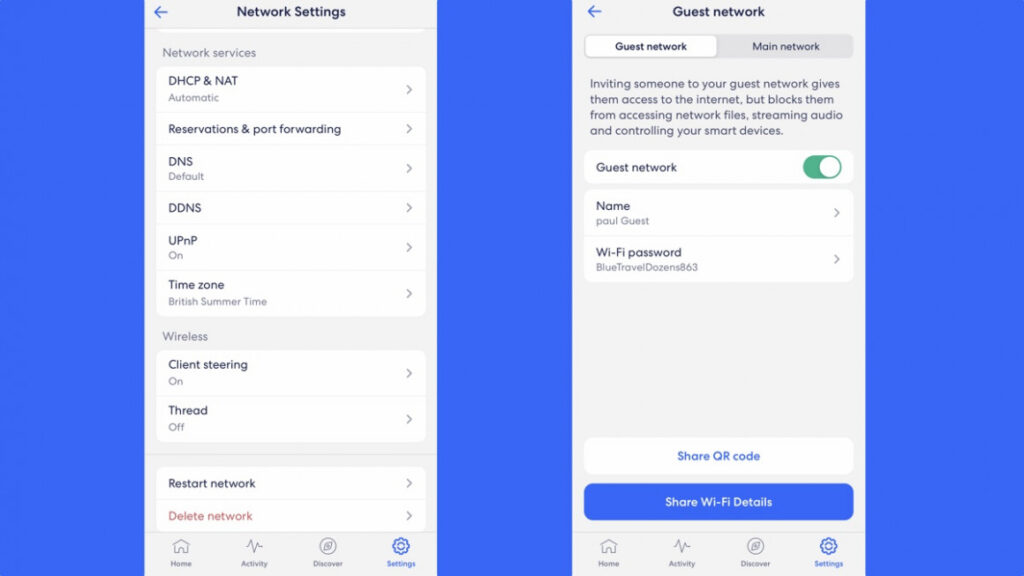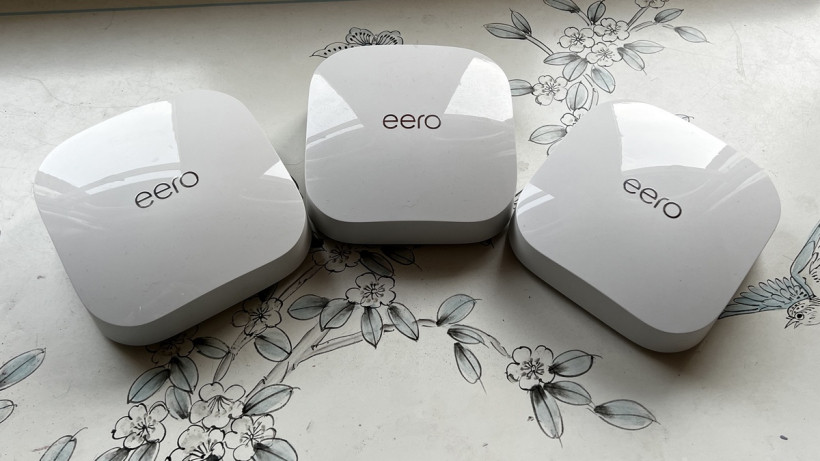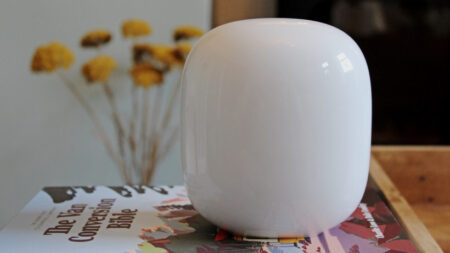Wi-Fi 6E added to popular mesh brand: here's our verdict
Fast, powerful and reliable, the Eero Pro 6E is capable of providing a very fast connection, particularly if you can get 6GHz networking. While it’s also the cheapest Wi-Fi 6E mesh system that I’ve seen, there are some caveats. First, given the scarcity of Wi-Fi 6E, most people will find that the cheaper Eero Pro 6 will give them the same performance for considerably less. The fact that the Pro 6 can use its second 5GHz network as a dedicated backhaul may actually give better performance. I suggest buying the Pro 6 today and adding on a Pro 6E satellite later on if you really want the 6GHz channel. While more expensive, the Netgear Orbi RBKE963 felt like an upgrade for the new technology, with a huge number of Wi-Fi streams, dedicated wireless backhaul, 10 Gigabit Ethernet internet ports, and more Ethernet ports per satellite. Plus, that system can split the 6GHz channel off on its own, so you know that you’re connected to the best network available.
Pros
- Easy to setup
- Cheap(ish) for Wi-Fi 6E
- Backwards compatible
Cons
- Alexa is fiddly
- No advanced network settings
- Limited Ethernet ports
Earlier this year Amazon took the covers off of its “fastest mesh Wi-System” yet, with the Eero Pro 6E going live.
The introduction of Wi-Fi 6E and its 6GHz channel have shown that wireless can truly compete with Gigabit Ethernet, delivering the kinds of speeds that we thought were impossible a few years ago.
Buying into this technology has, so far, been expensive; with the likes of the Netgear Orbi RBKE963 costing a small fortune.
However, you can buy Wi-Fi 6E for less with the Eero Pro 6E.
A step up from the Eero 6+ and an update on the Eero Pro 6 system that went live at the end of 2020, the Pro 6E – as you probably guessed from the name – adds Wi-Fi 6E to the mix.
Wi-Fi 6E is pretty much identical to Wi-Fi 6, with the big exception that 6E-packing devices will be able to tap into previously unlicensed wireless blocks in the 6GHz range.
6GHz Wi-Fi is a huge deal as it will allow the use of airwaves for routers and devices to use that doesn’t use overlapping signals like on some current Wi-Fi channels.
If you’re confused what all that means, check out our comprehensive guide to Wi-Fi mesh systems and, while you’re at it, have a read up on exactly what Wi-Fi 6 is.
Can this lower-cost mesh system really compete with the biggest and best? Our full review tells you all that you need to know.
Eero Pro 6E: Setup and specs
At $299 / £349 for just the Pro 6E router or $699 / £799 for a treble, it’s not ‘cheap’ exactly – but it is one of the most affordable tickets to the Wi-Fi 6E show.
In comparison, the (awesome) Netgear Orbi RBKE963 Quad-band Mesh WiFi 6E System costs $1,499 for a 3-pack.
The Eero Pro 6E is backwards compatible with all other Eero systems, so you could just buy one device for the faster speeds, integrating it with your existing network.
This is very good news for upgraders, who either want to add a new device to an existing network or use the existing devices as satellites on a brand-new, faster system.
Netgear should pay attention: its Wi-Fi 6E devices aren’t even compatible with the Wi-Fi 6 devices, let alone anything older.
Every single Eero device is identical, with two Ethernet ports on the back. This time around, there’s one Gigabit Ethernet port, plus a 2.5 Gigabit Ethernet port; the latter will run over existing Cat 5e cables, so you can get a wired speed boost without having to upgrade cabling.

Only having two ports is a little restrictive (certainly, in my house), so you’ll most likely need to buy some Ethernet switches if you’ve got lots of wired devices that you want to connect.
The first device that you connect to your modem becomes the router, and you can use either of the Ethernet ports for this job.
Of course, if you use the 2.5 Gigabit port for your internet connection, you only have the slower port left for wired devices.
Additional Eero satellites can then be connected over Wi-Fi or Ethernet.

Internally, each Eero Pro 6E satellite runs a 2×2 2.4GHz network (600Mbps), a 2×2 5GHz network (2400Mbps) and a 2×2 6GHz network (2400Mbps).
That’s a total of six streams, so 18 streams in total for a three-pack. That’s not bad, but the Orbi RBKE963 has a massive 16 streams per satellite, making it the superior choice for very busy networks; Eero says that this model is suitable for up to 100 devices.
What you don’t get with this model is a dedicated Wi-Fi backhaul for connecting the mesh system together, as you do with the Orbi range.
Instead, the Eero Pro 6E will use the best band possible for connection, although that does mean it has to share the bandwidth available for clients with the interconnection.
Of course, if you use Ethernet to connect the devices together, this issue goes away.
Eero Pro 6E: Features
Eero devices are designed to be easy to use, so there are far fewer options available here than with other routers.
Plus, everything is managed through the app, which connects via the cloud, with no web interface for more advanced settings.
As with all Eero systems, the app gives you very basic options: you can change the network name and password but that’s about it.
There’s no option to change the wireless channel, nor can you split the new 6GHz network off from the 2.4GHz and 5GHz networks: the network appears as one, as Eero sends clients to the best available network.
It largely works properly, with devices connecting to 5GHz mostly. Connecting to the 6GHz band was a bit hit and miss: my laptop connected to 6GHz automatically the first time, but would only connect to 5GHz a couple of days later until I ‘forgot’ the Wi-Fi details and reconnected.
The ability to split the 6GHz network off onto its own band would be really useful.

If you link the Eero Pro 6E to your Amazon account, then the system’s Zigbee hub is available through Alexa for adding new devices.
That’s potentially useful, although I’ve found that most devices, such as Phillips Hue bulbs, work best if connected to their matching hubs and apps.
Thread support is available, too, although this has to be manually turned on under the Network settings. Thread is a key component of the Matter standard. While it may not be that useful today; come the end of the year it will be way more important.
Alexa support is built-in, to a degree. The Eero app says that you can simply ask Alexa to turn the guest network on (or off), pause a device or toggle the status lights. It didn’t work for me, and I had to add the Eero Skill for Alexa to make it work.
Even then, the connection wasn’t perfect: asking Alexa to turn on the guest network had it turn on every status light instead. Judging by the reviews, that seems to be a common problem in the UK.
You can create profiles for family members and assign them devices. The basic Eero setup lets you pause a profile (and all of their devices) manually and on a schedule. If you want advanced web filtering, security and ad blocking, you’ll need Eero Secure (£2.99/$2.99 a month).
If you’d also like more protection, there’s Eero Secure+ (£9.99/$9.99 a month), which adds in a subscription for 1Password Family (five users), Encrypt.me (five users) and Malwarebytes (three devices).
TP-Link throws this kind of thing in, while Netgear splits its subscriptions between parental controls and the Armor security, the latter of which gives you client software for all devices. For Eero, the standard Secure plan seems the best value.

Eero Pro 6E: Performance
For most people, with standard Wi-Fi 6 devices running on the 6GHz band, the Eero Pro 6E has a very similar performance to the Eero Pro 6. That’s to say, it’s an extremely fast and reliable system.
The main wired router proved the fastest in my house, but placing an additional Eero system in the middle of the home gave me a connection right to the back of the house while wiring an additional satellite in gave me a connection in the office.
At range, performance does drop off, but even at the extremes of my house, I had more than enough bandwidth to stream 4K TV and download games at a fast-enough pace.
The Netgear Orbi RBKE963 was faster at range, with its dedicated wireless backhaul delivering more speed.
Switch to the 6GHz band, which only works reliably at short range, and there’s little difference in speed between the Orbi and Eero systems: both produced faster-than-Gigabit Ethernet speeds.





